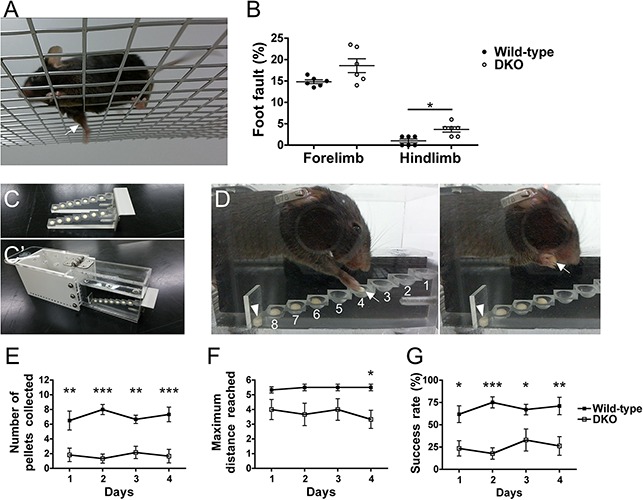FIGURE 8.

Grid-walking and staircase tests. (A,B) Grid-walking test. When one of the limbs fell below the grid surface during free walking on the grid (A, arrow), it was counted as a foot-fault error. (B) The foot-fault errors during the first 200 steps taken by the forelimbs and the first 50 steps taken by the hindlimbs were analyzed. The foot-fault rate was higher in the Sulf1/2 DKO mice than in the wild-type mice: the difference was significant in the hindlimbs (3.7 ± 0.6 vs. 1.0 ± 0.4; n = 6; ∗P < 0.05, Mann–Whitney U test) but not in the forelimbs (18.6 ± 1.6 vs. 14.8 ± 0.4; P = 0.065). (C–G) Staircase test. (C) Double staircase separated from the chamber. Single food pellets were placed on each well in the lower seven steps on both sides. (C′) Staircase test apparatus. The double staircase was inserted into the space between the platform and walls. A mouse was placed into the white chamber (left) and allowed to enter the central platform (right) and retrieve pellets for 30 min. (D) Video recording of mouse behavior. The mouse reached, grasped, and brought a pellet to its mouth successfully (arrows). When a mouse failed to retrieve a pellet, it was moved to a different well or to the inaccessible floor (arrowheads). (E–G) Results of the double staircase test. The “number of pellets collected” and “success rate” were lower in the Sulf1/2 DKO mice (n = 6) than in the wild-type mice (n = 6) throughout the test period (E,G). The “maximum distance reached” indicates the deepest well reached by the mouse. Please refer to the section “Materials and Methods” for a detailed description of the analysis. Data shown are means ± SEMs. Statistical significance was calculated using two-way repeated-measures ANOVA with a Bonferroni post hoc test (E–G; ∗P < 0.05, ∗∗P < 0.01, ∗∗∗P < 0.001).
